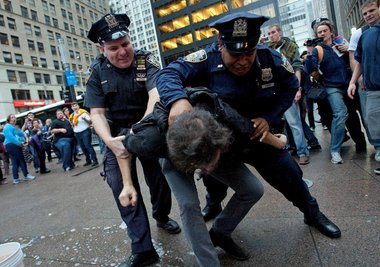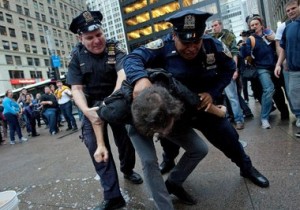Cops and Occupiers

Although the recent movement to Occupy Wall Street brought together such varied groups as students, activists, war veterans, labor unions, and beyond, the protests failed to attract significant attention until the media began to publish pictures and videos documenting clashes between the protestors and the police. Incidents highlighted by the media from the past few weeks include the now infamous video of white-shirt NYPD officer Anthony Bologna pepper spraying protestors standing behind a mesh police barrier as well as the arrests of more than 700 protestors on the Brooklyn Bridge for traffic violations at the beginning of October.
Some, including the NYPD, argue that much of the controversial footage can be explained by unfair vantage points and circumstances preceding the confrontations. But it is difficult to ignore the NYPD’s reputation for being quick to use force without appropriate provocation. While most of the publicized cases of police brutality recount isolated attempts to bring individual suspects into police custody, the NYPD has a reputation for its inability to adequately respond to protests. In fact, Officer Anthony Bologna had already been the target of lawsuits stemming from his actions during the 2004 Republican National Convention.
The NYPD does have an interest in preventing a riot and preserving peace, but it cannot overstep individual citizens’ constitutional rights in the process. Some compare the Occupy Wall Street protestors’ discontent with that of last spring’s Tea Party movement, which gained momentum in reaction to the new reforms in healthcare. However, the Tea Party never encountered the same violent resistance from police, even when some factions chose to exercise their second amendment rights to the point of militarism. One source notes:
During the height of the tea party movement, there were few confrontations with police. But violent rhetoric was often caught on camera and immediately uploaded onto YouTube. ‘If ballots don’t work, bullets will,’ tea party activist and radio talk show host Joyce Kaufman said at a rally about the midterm elections of 2010.
Last April, Tea Party leaders from Oklahoma City even proposed to create a volunteer militia to “defend their state’s rights against federal infringements.”
Although an NYPD spokesperson defends the use of pepper spray as appropriate and “relatively low on the so-called continuum of force available to [police officers],” something about the response pattern to the recent protests seems scattered and irresponsible. When a police scooter runs over and breaks a National Lawyers Guild legal observer’s leg or a policeman pepper sprays a Fox News reporter and hits his photographer with a nightstick, it is difficult not to question the necessity of such a violent reaction to what has been, for the most part, a civil protest. In the atmosphere of chaos and panic that accompanies a riot, it’s conceivable that a police officer may have to resort to a blanket spray of the crowd or swing his baton to hold a large crowd of people back. However, aside from making the morning commute for Wall Street employees really uncomfortable, and making a mess of Zuccotti Park, the OWS protestors have not inspired chaos or panic, and they have not threatened to use violent means if their demands are not met.
Furthermore, during the early days of the protest, the NYPD relied on an arcane 150-year-old New York statute outlawing the use of masks to arrest protestors. Based on the response pattern to the protests so far, the NYPD’s main purpose seems to be to shut down the movement by any means possible, when their goal, initially at least, should have been to monitor the protests. This boils down to the NYPD’s apparent lack of an adequate response plan to protests. Although the NYPD routinely uses pepper spray for disorder control, an “independent city agency that investigates accusations of police abuse said that about 400 people had complained, many from out of state” as a result of videos and photographs that have been released during the protests. What is an appropriate law enforcement response to non-violent demonstration? Maybe the NYPD could rethink their approach by seriously considering these complaints, or by using a liaison to initiate a dialogue with the protestors to ease some of the hostility. And protestors could benefit from a conversation with the police as well, to ensure that the movement isn’t overshadowed or misinterpreted as an adversarial movement against law enforcement.

